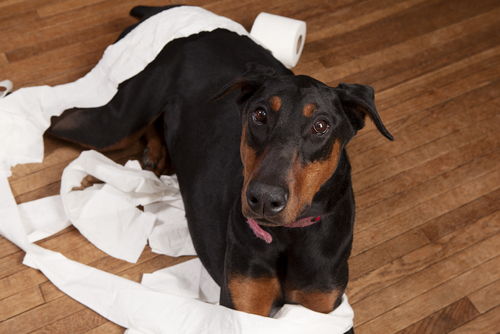We shared our lives with a very special dog. This dog was smart, sweet, respectful and incredibly gentle with the babies. Of course, since it was our dog, he did have a quirky side. He liked to eat things. Not chew, actually eat… consume various items.
It started with an occasional sock that would later be regurgitated for company like a neat party trick. It spread to stuffed animals, glasses, hats, the arm of the couch, a box spring, the driver’s side seatbelt in the car. We sought advice from friends who suggested spraying areas and objects with deterrents like bitter apple or various other scents. Those seemed to make the items more appealing to him, not less.
Our first Christmas together, after the tree had been trimmed, I noticed the dog had a shiny blue ball in his mouth. He bit down, I heard the crunch and immediately was on the dog, prying his mouth open and pulling shards of Christmas ornament out of his throat before he swallowed. Rushing him to the vet, I feared he had ingested some of the glass. His intestinal tract was safe, but the doctor diagnosed him with Pica.
What is Pica?
It is a compulsive disorder where a dog will eat things not usually consumable. Most dogs will eat their own stools or rocks. It is the odd ticked ones that consume other items. Behaviorists are torn as to why dogs suffer from an obsessive, compulsive disorder like Pica. Treatment is varied, depending on an established pattern.
 How does it start?
How does it start?
In puppies it may begin as an exploration. Most pups explore with their noses and mouths, some may begin consuming what they had already been chewing. Puppies often grow out of this behavior with a bit of training and maturity. The reasons an older dog may suffer from Pica vary greatly. It may be out of boredom, stress in the household, lack of attention, crated for long periods of time, lack of dietary balance, or merely a brain glitch.
Treatment Options?
Consulting with a qualified canine behaviorist would be an owner’s best bet. The behaviorist will come, assess issues and design a program to help the dog and owner find peace. First order of business is to rule out what is causing the behavior. In our case, exercise and isolation were ruled out. But our home was under some (a lot of) stress and the dog’s food wasn’t as healthy as we had thought.
Verbal scolding is often frowned upon by most experts. They feel it is reinforcing the behavior by offering attention to the dog who craves to be noticed. It also compounds fear of the owner, the dog will still engage in these negative behaviors, when the owner isn’t present.
If an owner feels their dog suffers from Pica, they should talk to their veterinarian. If it is confirmed the dog does suffer from this disorder, a qualified animal behaviorist should be consulted. It is possible to deal with this without one, but it helps to have a professional guide the recovery process. The behaviorist offers owners peace of mind that they are on the right training path, not merely assuming they are.
